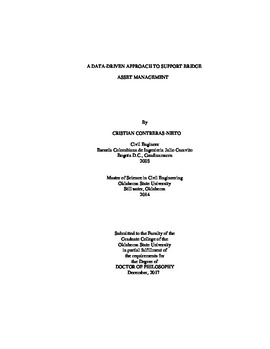| dc.description.abstract | Economic growth and reduction of poverty lies in a well-planned, constructed, and maintained infrastructure that includes water and sanitation networks, airports, schools, health facilities, and highways systems. As bridges are an integral component of the nation's highway system infrastructure, deficient bridges without timely maintenance may endanger the public and affect the economy on a broader scale. Currently, more than the 9.0% of the bridges in the U.S. are graded as structurally deficient, and the new estimate to address these bridges is $123 billion. Thus, in order to keep the level of safety and serviceability of these infrastructure assets, efforts in an accurate prediction of condition ratings, a better characterization of deficient bridges, and a focus on prioritization of deficient bridges can help. Currently, bridge stakeholders face budget constraints; thus, they need a systematic approach to better estimate maintenance budgets, make informed decisions in bridge design, and prioritize bridge maintenance. This dissertation research has two major objectives. The first objective is to provide a framework to predict and characterize superstructure deficiency. The second objective is to present a methodology to prioritize bridge maintenance. This dissertation used NBI databases as the main data source and utilized data mining techniques, multi-criteria decision analysis, and GIS to achieve the objectives of the study. Moreover, this dissertation follows a three-journal paper format. The first paper addresses the development of a framework to create predictive models of superstructure ratings for steel and prestressed concrete bridges. The second paper identifies a framework to characterize superstructure deficiency of steel bridges. The third paper presents a decision-making framework to prioritize bridge maintenance through using aggregate bridge ratings and average daily traffic (ADT). This dissertation contributes to the overall body of knowledge by establishing frameworks to develop reliable models to predict superstructure ratings, identify factors that accelerate superstructure deficiency, and prioritize bridge maintenance. The results of this dissertation can be used by any bridge stakeholder to complement their current bridge management programs. | |
